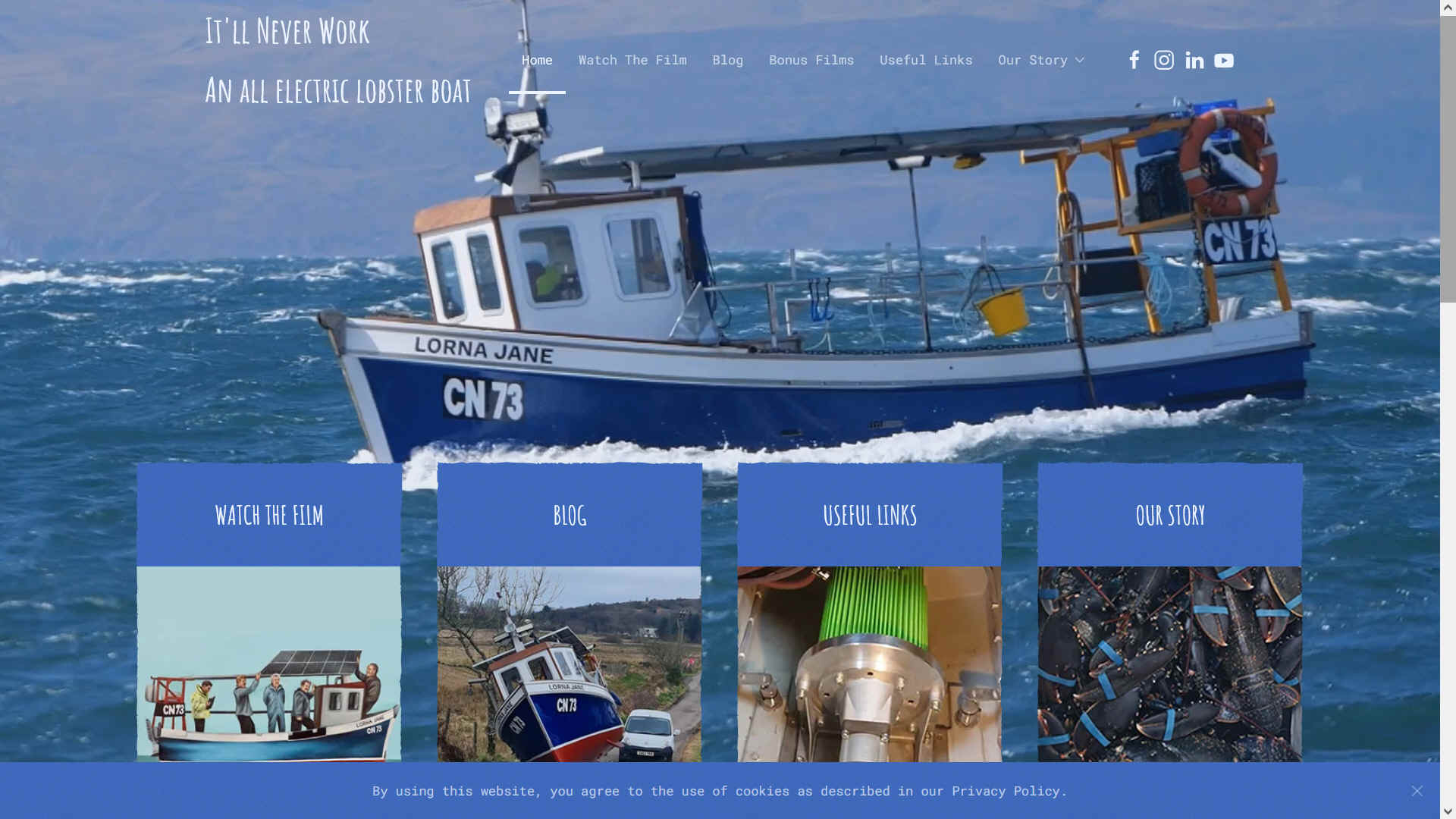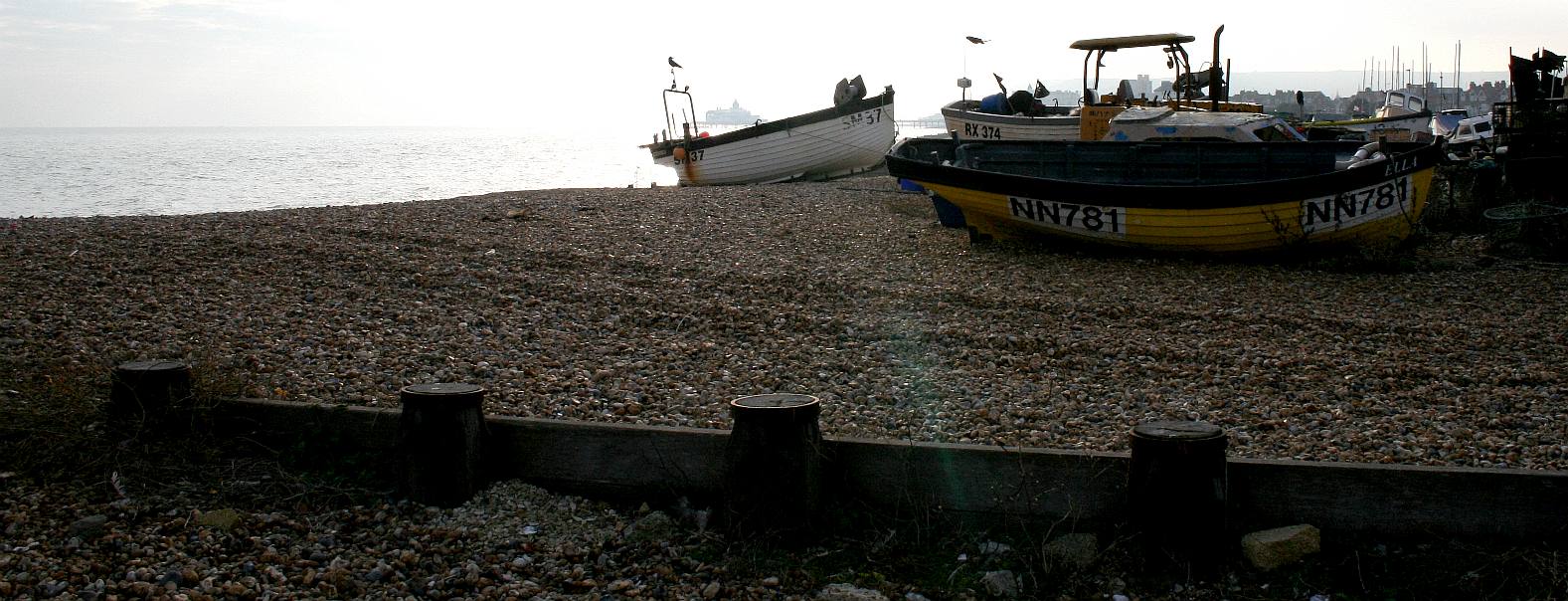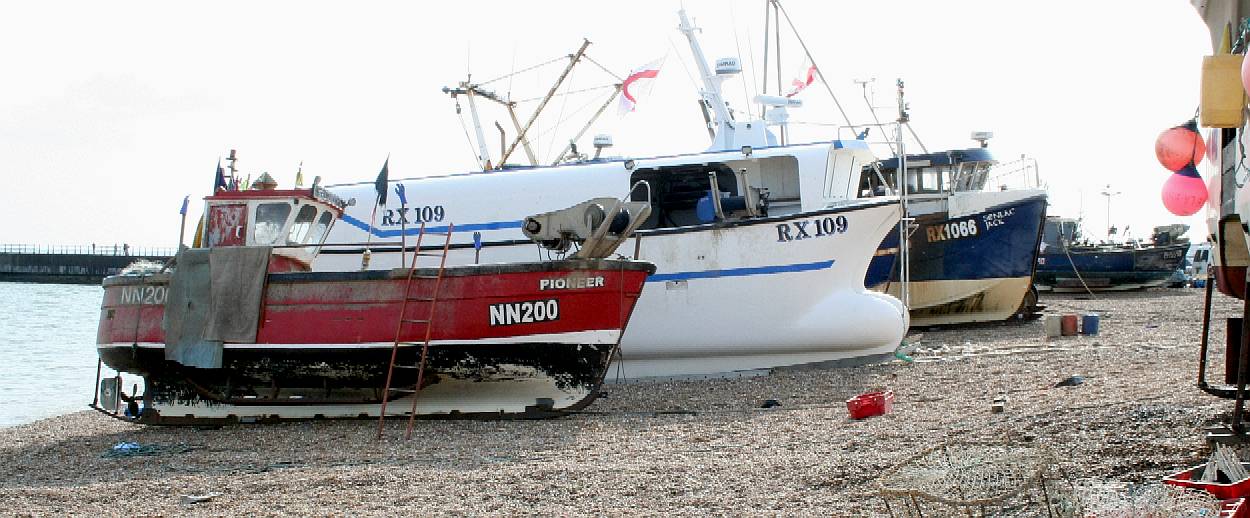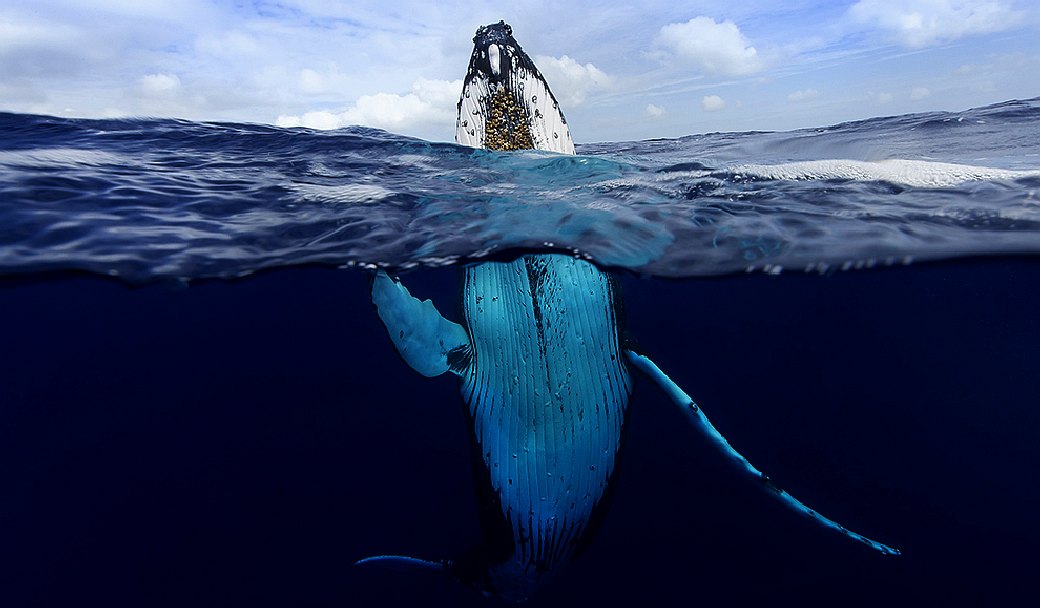|
LORNA
JANE - HANS UNKLES
PLEASE
USE OUR
A-Z INDEX
TO NAVIGATE THIS SITE WHERE PAGE LINKS MAY LEAD TO EXTERNAL
SITES,
or: HOME

CHALLENGING
TIMES -
Feeding the world securely into the future is one
of the major challenges facing mankind and one we must rise to
meet to avoid famine and suffering. The planet can only
generate so much food from base life forms that convert
sunlight into energy for plant growth, then to move up the food
chain as animals eat plants.
The
Lorna Jane is a practical demonstration of an all electric lobster potting
boat, encompassing hauling, towing, weather and other daily functions.
The videos on this page are intended to show the capabilities and restrictions of working an all
electric
lobster fishing vessel. Currently the boat is fully certified and
fishing at a commercial level on the west coast of
Scotland.
Hans Unkles is an inspiration to others. We take his point
about red tape, being the killer of innovative entrepreneurs.
The bean counters are effectively stealing his intellectual
property and know how, slowing development down, and draining
the creative soul of the innovator. All for their pound of
flesh, building their part, and pension pots. That is the
bottom line of regulations.
The
solar panels are rigidly fitted on an overhead gantry, without
adding too much weight to the base vessel. The bifacial panels
offer some advantage over traditional monoface units. Windage
roll is offset by the heavy batteries placed low in the hull.
The SeaVax
and Elizabeth
Swann concepts include solar wings that track the sun,
adding mass in return for more energy. The Swann is presently under development without funding from any
government sources. Hence, slowly, but with less stress and
reduced official interference. A trimaran hull offers greater
efficiency, speed and range, though less well suited to
working boats. Whereas, the SeaVax
configuration is suitable for use as a fishing boat, but
simply replacing the plastic harvesting apparatus with
suitable alternative harvesting kit. Although, this concept is
completely untried.
The
base vessel was a 1978 Cygnus GM21, converted to all electric and solar power.
Hans says it makes more sense to concentrate on conversions over new builds as there are so many existing boats and hulls that lend themselves to an electric conversion. The Cygnus 21 is a fairly substantial boat for its size but, in reality, not much bigger than an open dinghy.
He says it is the Grey Fergie of the fishing industry. A small, reliable, manageable and solid workhorse.
Hans Dinkles runs a one man company called Sandisland Workshop Ltd where
he undertakes boat refits and repairs.
His business evolved through 40 years of Scallop diving, Lobster,
crab and prawn fishing, a boat building apprenticeship and many yacht and fishing boat refits. The decision to convert a boat to all electric grew over a couple of years. For a long time
Hans has been fascinated or drawn to the concept of generating energy with natural resources. 27 years ago
his house was powered by a wind turbine and now 25% of all the power
they use, including 20,000 miles a year between a car and a van is all powered by
their own solar panels.

EASTBOURNE -
Right on our doorstep is an example of a beach that is underused for fishing, even
though there is a Fisherman's Agreement in existence and blue
growth is clearly on the agenda locally. This may change if a
home is found for new technology aiming for sustainable
fishing in Europe and Internationally. For example, the AmphiMax
beach launching and recovery system holds the potential to
make selective fishing
more attractive using modified SeaVax
boats, and as a bonus to climate considerations, these
boats are not dependent on diesel
fuels for operation. At the moment fishermen operate from the Sovereign
Harbor marina complex. Hastings, just a few miles further
east along the English
Channel is just the opposite, with fishing boats forming a
major part of the community.

THE
STADE - The famous Sussex
beach has a steep slope lead in that is ideal for launching,
followed by a more gently inclined beach that is ideal for
beaching. What is so fascinating about the boats here is the
variety of designs all to tackle the awesome task of launching
a medium weight vessel from the beach and then recovering it -
as economically as possible. As part of our lighting
feasibility study, this is the place to start, to see how
hundreds of practical fisherman and marine engineers have
risen to the challenge. Copyright © May 29 2016, all rights
reserved. You will need permission from Bluebird
Marine Systems Ltd to reproduce this photograph.
LORNA
JANE'S SPECIFICATION
Epropulsion E175 batteries 9kw 48v x 5. Individually 50cm ◊ 51.5cm ◊ 26 cm and weigh 87kg. Total 50 x 51.5 x 1030 and 430kg. Lithium Iron Phosphate is currently the safest battery chemistry available. The batteries are off the shelf supplied in a steel casing. They have multiple sensors for high/low temperature, over and under voltage and will shut themselves down to protect themselves. They also can be switched off on the battery so the terminals are not live which is really useful for working around them. 2 epropulsion mains chargers rated at 16amp each are used on a standard 16amp shore power plug or with a 32 amp adaptor if 32amps is available.
Fischer panda Aziprop 20kw 1200rpm pod drive. The pod comes with a control box to invert the voltage from 48vdc to 48vac 3 phase. This allows the 6 x 70mm2 cabling to carry the amps needed to power the motor. There is also dual steering controls and a performance read out to monitor revs, power used, time to go at current consumption and solar or charge input.
JA solar 460w bifacial PV x 4 from Bimble solar provide a potential 1.8kw of charging input. Bifacial panels will also charge from the under or backside so are ideally suited to boat applications where there is significant reflected light from the sea.
THE
COST OF LORNA JANE (EXCLUDING VAT)
Aziprop motor and hardware..................£19,109.66
Epropulsion Batteries.............................£20,419.81
Electric Hydraulic complete system..........£6,424.16
Bimble Solar.........................................£1,172.50
Installation equipment...........................£10,295.25
Administration time...............................£20,000.00
Construction time.................................£40,000.00
Original vessel value.............................£20,000.00
Net..................................................£137,421.38
Funding............................................-£34,865.87
Total................................................£102,555.51

SEAFISH - STEAMING ON SUNSHINE: THE UK'S FIRST SOLAR POWERED FISHING VESSEL
Inshore lobster potter and boat builder, Hans Unkles, converts the Lorna Jane into the UK's first fully approved electric commercial fishing vessel.
Hans Unkles, a fisherman from the small rural village of Tayvallich, Scotland, has a rich history in the industry.
The 61-year-old's journey began as a boat builder and itís believed he has constructed and refurbished around 20 boats.
He has skippered/owned nine different potting vessels; currently fishing the 6.4m Cygnus - the Lorna Jane, named after his daughter, targeting lobsters two to three days a week.
But longer-term, Hans started to worry about the vessels of the future, leading him to take a serious look at using renewable energy as the power source for the Lorna Jane.
His expertise, combined with a passion for renewable
energy, perfectly positioned Hans to install solar panels and help convert the Lorna Jane into the UK's first fully electric commercial fishing vessel.
The vessel has now successfully converted to solar power, earning full Maritime and Coastguard Agency (MCA) accreditation.
The diverse requirements across the fleet segments, means there is no-one-size fits all solution for vessels where emerging propulsion technology/fuel systems are concerned. In the interim, regulatory derogations, as with the Lorna Jane, will be necessary and considered on a case-by-case basis.
CURRENTS OF CHANGE
The Lorna Jane only fished one season in very local waters before the retrofit, so comparing fishing practices before and after the solar installation is data limited.
But before the conversion, Hans estimates the vessel consumed 20 litres of
diesel per day, to travel an average of 15 miles, costing around £20 per return trip.
While the converted vessel still uses an industry-standard Spencer Carter Hauler, there is now a new power sourceóa 10kW electric motor, which he has derated to 4kW on efficiency grounds.
The motor draws its power through the main battery bank charged via 4 x 460W bifacial solar panels, capturing both direct sunlight and sea reflection - powering the hauler and vessel propulsion.
The Lorna Jane averages 26 miles per day, with its range depending on throttle. On a cloudy day without solar input, the Lorna Jane has a continuous range of 60 miles at five knots; reducing to 25 miles at six knots.
In winter, when solar power alone is not sufficient, the boat must moor at a neighbouring port with a pontoon that offers access to shoreside charging via a plug-in recharging point. During these months, Scotland benefits from abundant
wind power generation (The Scottish Government, 2022), enabling the vessel Lorna Jane to maximize renewable energy utilisation throughout the year.
However, the portís tariff is high at £0.75/kW and the additional overnight mooring fee must be factored in. During the commissioning stage, the solar charger also faced issues, leading to a temporary reliance on a generator. Despite these challenges, the overall cost of powering the boat has now reduced to around £17 a day from July to December.
Individuals already operating from a port equipped with shore power may exclude the additional pontoon expenses from their calculations, and check their local electricity tariffs, which are often far lower.
When focusing solely on electricity costs, the Lorna Jane averages £10.12 per day.
SOUND OF SILENCE
Itís difficult to determine the life-expectancy of the retrofitted equipment, as the Lorna Jane has not been in operation long enough, making it necessary to rely on the manufacturerís estimates.
The batteries have a 3,000 charge-cycle specification. However, without the need for components such as impellers, fuel filters, oil changes, leaky pipes,
water flow systems and alternators - all of which are susceptible to daily wear and tear - maintenance costs are expected to be substantially reduced. Hans also now enjoys the unpolluted sea air and symphony of silence when the vessel is steaming to and from the fishing grounds.
A DRAWN OUT PROCESS
The Lorna Jane was substantially modified before converting to electric; this increased the overall time taken to around eight months. It involved deck raising and a new wheelhouse - essentially rebuilding the vessel. Hans was in an unusual position when applying for Marine Scotlandís Maritime and Fisheries Grant, playing the part of both the fisherman and the boat builder!
Unfortunately, the available funding neither covered his time, or the equipment already purchased, leaving Hans largely out of pocket. He believes the whole conversion cost approximately three times the value of an equivalent unconverted vessel with license. Therein lays one of the biggest challenges associated with transitioning existing vessels to
carbon-free steaming Ė namely how to make the figures stack up economically.
In pioneering the first vessel of its kind in the UK, Hans faced the challenge of needing to start the authorisation process from scratch with the MCA, to secure the necessary regulatory derogation; working closely with a senior MCA surveyor and his team, as well as employing a naval architect to submit time-consuming drawings. Although the process was lengthy, MCA successfully calculated how to apply existing codes of practice, making it easier for anyone in the future.
'WATT' ARE THE CHALLENGES
Scotland may not be considered a sunny place, yet the latitude results in long summer days. However, for those fishing full-time or over the winter, additional power to recharge the vesselís batteries will be essential.
With most ports and particularly small harbours currently lacking shore power facilities, it is not a viable option for many. Successfully delivering
net zero across the UK fishing fleet, and
aquaculture service vessels, will require a fit-for-purpose shore-to-vessel-to-shore transition, together with the appropriate infrastructure, operational requirements and funding. This will be crucial to avoid supply chain blockages, be these technical, regulatory etc.
Currently, vessel owners may be able to undertake repairs independently, but transitioning to fully electric vessels require specific skills development and training. Hans further predicts vessels over nine metres will likely require a higher voltage, where a qualified electrical engineer is legally required for any installation and maintenance work. The necessary skills and training across the fishing sector, whether for fishermen or boat yards, need mapping and a development framework put in place.
LOOKING TO THE FUTURE
Vessels have been steadily increasing their speed over the years however, there is now a notable shift in perspective among many vessel owners who are prioritising fuel efficiency whenever feasible.
With the simplest method being to decrease speed, there may be more of a return to slower boats like the Lorna Jane. The solar powered motor seems well-suited for the smaller under-10m inshore day-trip fishing boats that utilise static gear. With 2,742 under 10m vessels operating across the UK in 2022 (Seafish, 2023), as well as
aquaculture service vessels, solar power presents a potentially exciting solution.
Hans describes himself as optimistic about the shift to electric power, emphasising the need for fishermen to change their mindset going forward.
USEFUL
CONTACTS
Hauler motor and switchgear, Josh Masters -
www.lightningcraft.co.uk
E175 Epropulsion batteries. They also supply motor and battery sets. Competitive sales with back up -
www.epropulsion.uk
Fischer Panda UK. Big established company with a long history, selling a refined product, really helpful
-
www.fischerpanda.co.uk
The motor used - https://www.fischerpanda.co.uk/res/20191106_Handout_20kw1200AZ-UK.pdf
Solar PV suppliers with good support - www.bimblesolar.com/
Solar and battery components with knowledge and advice - www.sunshinesolar.co.uk
Hydraulics supplied by - www.spencercarter.com/
LINKS
& REFERENCE
https://www.seafish.org/responsible-sourcing/climate-change-and-the-seafood-industry/steaming-on-sunshine-the-uk-s-first-solar-powered-fishing-vessel/
https://www.seafish.org/responsible-sourcing/climate-change-and-the-seafood-industry/steaming-on-sunshine-the-uk-s-first-solar-powered-fishing-vessel/
https://hmcoastguard.uk/news/quiet-revolution-lorna-jane-becomes-first-electric-vessel-join-uk-fishing-fleet
https://www.itllneverwork.boats/
https://www.itllneverwork.boats/

MARINE
LIFE - This humpback whale is one example of a magnificent
animal that is at the mercy of human
activity. Humans are for the most part unaware of the harm their fast-lane
lifestyles are causing. We aim to change that by doing all we
can to promote ocean
literacy.
This
website is provided on a free basis as a public information
service. Copyright © Cleaner
Oceans Foundation Ltd (COFL) (Company No: 4674774)
2025. Solar
Studios, BN271RF, United Kingdom.
COFL
is a charity without share capital.
|




